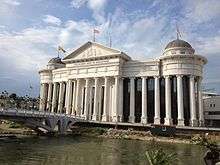Architecture of North Macedonia
Architecture of North Macedonia refers to architecture ever practised on the territory of present-day North Macedonia.
The several groups of people who have settled or controlled today's North Macedonia have influenced the country in many ways, one of the most visible being architecture. These groups of people include the Paionians, Illyrians, Ancient Macedonians, Romans, Byzantines, Slavs and the Ottomans.
Early architecture
The earliest example of architectural activity in North Macedonia date from the Neolithic and consist of structures associated with Megalith culture. Kokino is the fourth oldest megalithic observatory in the world. The site consists of rocks crafted in a way that lets one observe celestial objects.[1]
Architecture of Ancient Macedonia
Remnants of the architecture from the times of the ancient Macedonian Kingdom are scattered throughout North Macedonia, especially in the south of the former territory of Macedon.
Heraclea Lyncestis, founded in the middle of the 4th century BC, was an important strategical town as it bordered Epirus to the west and the Paeonian kingdoms to the north. Roman architecture dominates the site today because of the level of the excavations which are exposing the layers from the Roman times.
The Ancient Theatre in present-day Ohrid was built during the 1st century BC. It was part of the ancient town of Lychnidos. It is reconstructed and in use today. Its location between two hills that surround it keep it protected from winds that could interfere with acoustics during performances.
Roman architecture
Roman architecture is scattered throughout the country. Skopje is home to a few examples of this type of architecture. One is the Skopje Aqueduct, the only aqueduct in North Macedonia. It consists of 55 stone arches. Another example is Scupi. Although not much remains of this archaeological site, burial grounds and a theatre are somewhat visible.
Although it was founded by the Ancient Macedonians, most of the remains of Heraclea Lyncestis are from Roman occupation. These remains include a portico and a large theatre.
Other examples of Roman architecture in North Macedonia includes the many Roman ruins in and around the town of Strumica. One of the largest is a well-preserved Roman therma, built during Late Antiquity.
Byzantine architecture
Byzantine architecture is one of the most prominent forms of architecture in North Macedonia. It is mostly seen in churches and monasteries, such Treskavec monastery near Prilep.
Ottoman architecture
The Ottomans controlled the land of present-day Macedonia for about five centuries. They left their mark with the many mosques and other Islamic buildings they constructed.
Ottoman architecture is predominant in some parts of Skopje, especially the city's old town. Mustapha Pasha Mosque is one of the most famous Ottoman buildings in North Macedonia. Built in 1492, the mosque is square in shape and the diameter of the dome is 16 meters. The pillars of the porc hare decorated by stalactite decorations that are typical of Ottoman architecture.[2]
Ottoman architecture can also been seen in Bitola and Tetovo.
19th-century architecture
Examples of neoclassical or baroque architecture are throughout the country but can be rare and limited to one structure per city. Neoclassical architecture can be seen in Skopje (Ristiḱ Palace). The exception to this pattern is in Bitola. Širok Sokak street is filled with neoclassical and baroque architecture and a Gothic Catholic church.
 Skopje center in the 19th century
Skopje center in the 19th century Skopje's National Theatre and Kale Fortress before the 1963 earthquake
Skopje's National Theatre and Kale Fortress before the 1963 earthquake- The Ristiḱ Palace in Skopje
Yugoslav architecture
Interwar modernism
Yugoslav architecture emerged in the first decades of the 20th century before the establishment of the state; during this period a number of South Slavic creatives, enthused by the possibility of statehood, organized a series of art exhibitions in Serbia in the name of a shared Slavic identity. Following governmental centralization after the 1918 creation of the Kingdom of Yugoslavia, this initial bottom-up enthusiasm began to fade. Yugoslav architecture became more and more dictated by an increasingly concentrated national authority which sought to establish a unified state identity.[3]
Beginning the 1920s, Yugoslav architects began to advocate for architectural modernism, viewing the style as the logical extension of progressive national narratives. The Group of Architects of the Modern Movement, an organization founded in 1928 by architects Branislav Đ Kojić, Milan Zloković, Jan Dubovy, and Dusan Babic pushed for the widespread adoption of modern architecture as the "national" style of Yugoslavia to transcended regional differences. Despite these shifts, differing relationships to the west made the adoption of modernism inconsistent in Yugoslavia WWII; while the westernmost republics of Croatia and Slovenia were familiar with Western influence and eager to adopt modernism, long-Ottoman Bosnia remained more resistant to do so. Of all Yugoslavian cities, Belgrade has highest concentration of modernist structures.[4][5]
 The Skopje City Hospital was designed in 1930 by Drago Ebler
The Skopje City Hospital was designed in 1930 by Drago Ebler
Socialist realism (1945–48)
Immediately following the Second World War, Yugoslavia's brief association with the Eastern Bloc ushered in a short period of socialist realism. Centralization within the communist model led to the abolishment of private architectural practices and the state control of the profession. During this period, the governing Communist Party condemned modernism as "bourgeois formalism," a move that caused friction among the nation's pre-war modernist architectural elite.[6]
Socialist modernism
Socialist realist architecture in Yugoslavia came to an abrupt end with Josip Broz Tito's 1948 split with Stalin. In the following years the nation turned increasingly to the West, returning to the modernism that had characterized pre-war Yugoslav architecture.[5] During this era, modernist architecture came to symbolize the nation's break from the USSR (a notion that later diminished with growing acceptability of modernism in the Eastern Bloc).[6][7]
Spomeniks
During this period, the Yugoslav break from Soviet socialist realism combined with efforts to commemorate World War II, which together led to the creation of an immense quantity of abstract sculptural war memorials, known today as spomenik [8]
Brutalism
In the late 1950s and early 1960s Brutalism began to garner a following within Yugoslavia, particularly among younger architects, a trend possibly influenced by the 1959 disbandment of the Congrès Internationaux d'Architecture Moderne.[9]
Brutalism's growing influence in the nation was most prominently exemplified in reconstruction efforts of Skopje following a destructive 1963 earthquake.[10] Japanese architect Kenzo Tange played a key role in pushing for brutalism in the city, going so far as to propose a full redesign of Skopje in the style.[11][12]
Decentralization

With 1950s decentralization and liberalization policies in SFR Yugoslavia, architecture became increasingly fractured along ethnic lines. Architects increasingly focused on building with reference to the architectural heritage of their individual socialist republics in the form of critical regionalism.[13] Growing distinction of individual ethnic architectural identities within Yugoslavia was exacerbated with the 1972 decentralization of the formerly centralized historical preservation authority, providing individual regions further opportunity to critically analyze their own cultural narratives.[3]
Contemporary architecture
Most of the modern buildings in North Macedonia are located in central Skopje. One example is the MRT Center (the national TV broadcast station),rising to 230 ft (70.10 m) (70 m) which was the tallest building in the country until 2013 when the Cevahir Towers were build. Examples of modern architecture are also found in other cities, mainly Bitola and Gostivar.
Skopje 2014

Skopje 2014 was a project with the purpose of giving the capital Skopje a more classical appeal, by constructing several buildings, mostly in the neoclassical style, which has drawn criticism from architects as being kitsch.
References
- Kokino Official Website Archived December 6, 2008, at the Wayback Machine
- Culture in MK
- Deane, Darren (2016). Nationalism and Architecture. Taylor & Francis. ISBN 9781351915793.
- Đorđević, Zorana (2016). "Identity of 20th Century Architecture in Yugoslavia: The Contribution of Milan Zloković". Култура/Culture. 6.
- Babic, Maja (2013). "Modernism and Politics in the Architecture of Socialist Yugoslavia, 1945-1965" (PDF). University of Washington.
- Vladimir., Kulić (2012). Modernism in-between : the mediatory architectures of socialist Yugoslavia. Jovis Verlag. ISBN 9783868591477. OCLC 814446048.
- Alfirević, Đorđe; Simonović Alfirević, Sanja (2015). "Urban housing experiments in Yugoslavia 1948-1970" (PDF). Spatium (34): 1–9.
- Kulić, Vladmir. "Edvard Ravnikar's Liquid Modernism: Architectural Identity in a Network of Shifting References" (PDF). New Constellations New Ecologies.
- di Radmila Simonovic, Ricerca (2014). "New Belgrade, Between Utopia and Pragmatism" (PDF). Sapienza Università di Roma.
- Lozanovska, Mirjana (2015). "Brutalism, Metabolism and its American Parallel". Fabrications. 25 (2): 152–175. doi:10.1080/10331867.2015.1032482.
- "Curating the Yugoslav Identity: The Reconstruction of Skopje | post". post.at.moma.org. Retrieved 2019-02-01.
- "Reconstruction Plan for Skopje". architectuul.com. Retrieved 2019-02-01.
- Entertainment, The only biannual Magazine for Architectural. "YUGOTOPIA: The Glory Days of Yugoslav Architecture On Display". pinupmagazine.org. Retrieved 2019-02-05.
.jpg)
